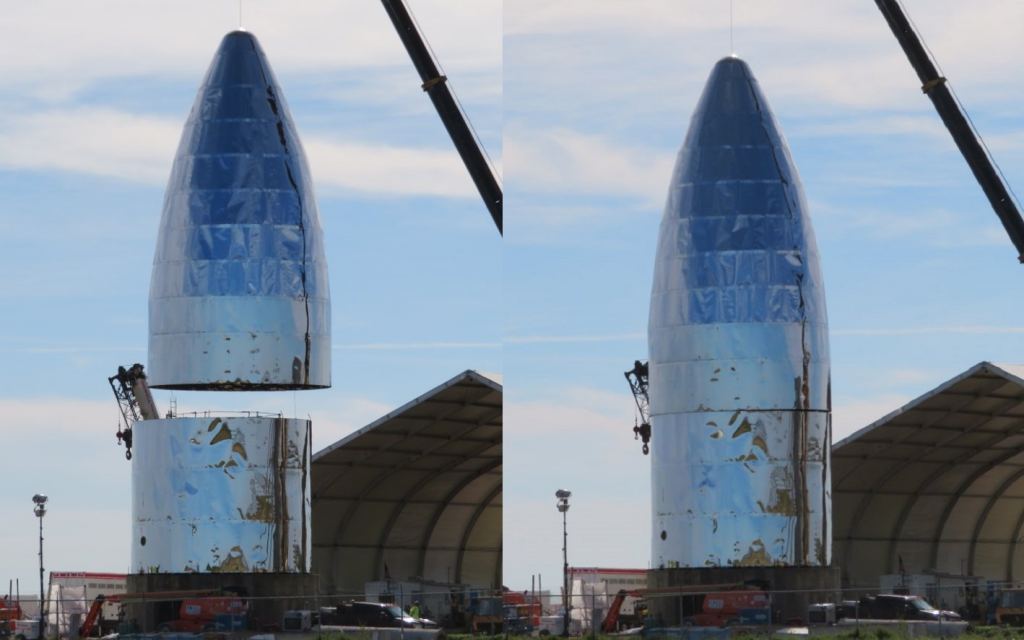This year, SpaceX will test out a miniaturized version of its super-heavy launch vehicle, which is known as the Starship (aka. the Big Falcon Rocket). This test launch will validate the design of the rocket and how it fairs at supersonic speeds and deals with the cryogenic environment of space. It will also serve as an opportunity to conduct the delivery of the next batch of SpaceX's Starlink satellites.
Recently, Musk tweeted images of sections of the mini-Starship (Starship Alpha, the Starship hopper) being brought out at the company's South Texas Launch Site in Boca Chica, Texas, for assembly. From the latest images that have been shared by multiple sources, it is clear that SpaceX crews have been working round the clock and through the holidays to get the hopper ready for its test flight later this year.
News of the updated assembly - which included the possible integration of three Raptor engines - began making the rounds after a series of photos were posted on NASA Spaceflight'sboard on Dec. 31st. These were taken by a member of the National Space Foundation (NSF) - who goes by the handle bocachicagal - and drew attention to the three nozzles that were apparent on the aft section.
This was followed on Jan. 1st by images being posted to twitter by Austin Barnard, a space enthusiast who has been visiting the Boca Chica site regularly since the hopper components were first brought out. These images showed the work being done on the nose cone and the rear section of the hopper. Photos of the latter once again showed three engine nozzles apparent at the bottom.
The appearance of these nozzles mirrored statements made by Musk in the past few weeks about the company's plans to test the hopper. According to these statements, the full-scale model of the Starship/BFR will be conducting a series of hop tests that will involve the Raptor engines taking it to relatively low altitudes above Boca Chica, Texas.
This was confirmed by Musk on Jan. 5th via twitter when he answered questions about whether the nozzles were actual Raptor engines or just "place holders" for the real thing. As Musk tweeted:
This statement pushes the date of the Raptor's test firing back a little from what Musk claimed in December. When asked about the "radically redesigned" Raptor engines that will be used for the Alpha's test flight, he tweeted that it would be "ready to fire next month." It now looks like the company will be waiting until February to put the engine through its paces at the SpaceX Rocket Development Facility in McGregor, Texas.
Further photos of the assembly process were posted by bocachicagal on NASA Spaceflight between Jan. 1st and Jan. 4th. These photos showed more progress being made on the hopper, which included the nose cone and hull section, which were now covered in a silvery-metallic skin, as well as an American flag being attached to the hull. Also noticeable were vent holes in the hull section.
This silvery skin was the subject of interest, as it appeared that the entire rocket was being covered in it. Initially, it was not clear if this skin was meant to be a permanent feature of the Starship hopper, or if it was a temporary addition to prevent damage to the assembled prototype. Musk addressed this as well by releasing an image via twitter of what the completed prototype would look like.
Musk captioned the tweet with the words, "Starship test vehicle under assembly will look similar to this illustration when finished. Operational Starships would obv have windows, etc." It therefore stands to reason that this sheet of metal skin in integral to the design of the hopper, which Musk previously revealed is made from a stainless steel composite.
Artist's impression of what the completed Starship Alpha will look like. Credit: SpaceX
One of the key advantages of this material is the reflectivity, which makes it highly-resistant to heat. The hull will therefore require less in the way of heat shielding, which saves on the weight of the craft. In this respect, the silver skin could very well be an added layer of reflective coating to ensure the hull performs well when exposed to the extreme heat of reentry.
Subsequent images posted by bocachicagal on Jan. 4th that showed the nose cone being integrated with the last section of the hull and then moved next to the "water tank". Images posted on Jan. 5th by Austin Barnard showed the two sections positioned next to each other and the aft section being covered in the same silver skin.
At this point, it looks like the two sections - fore and aft - are near completion and will soon be integrated with each other. Musk also addressed questions of when the hop tests would be conducted, tweeting, "Aiming for 4 weeks, which probably means 8 weeks, due to unforeseen issues." According to this schedule, SpaceX should have no problem getting the hopper ready for its scheduled flight test in June 2019.
If all goes well, we can expect construction to begin on a full-scale prototype of the Starship/BFR in late 2019 or early 2020. Based on the tentative dates Musk has provided in the past, it is hoped that the Starship will be ready to conduct its first cargo flights as early as 2022, the first lunar passenger flight in 2023, followed by the first crewed flight to Mars by 2024 and the construction of Mars Base Alpha by 2028.
Be sure to check out this video by "astronogamer" Scott Manley, who offers his take on the evolving look and structure of the Starship hopper:
*Further Reading: Teslarati*
 Universe Today
Universe Today

